Sep 12, 2025
Sep 12, 2025
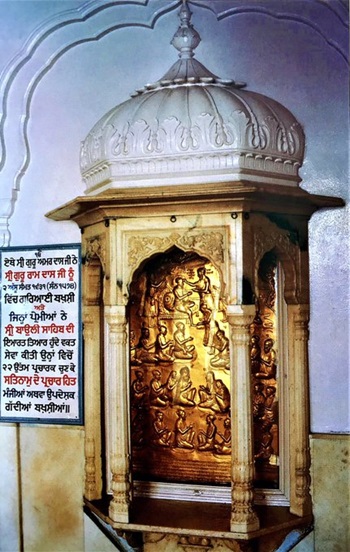 Before printed books became common, a written, authentic documentation of historical events of those days, including authentic record keeping were not the widely accepted traditions. Those were the times when the transfer of knowledge and information through generations was by oral traditions. So, the information can change over time and over generations.
Before printed books became common, a written, authentic documentation of historical events of those days, including authentic record keeping were not the widely accepted traditions. Those were the times when the transfer of knowledge and information through generations was by oral traditions. So, the information can change over time and over generations.
However, as regards to Guru Ram Das Ji, we are fortunate to have Guru Ji’s own, plus Bhatt’s authentic accounts in Guru Granth Sahib. Besides these there are Vaarans by Bhai Gurdas (1551 – 25 August 1636) a contemporary which offer glimpses of Guru Ram Das’s life.
Guru Ram Das Ji was born as Jetha (meaning eldest) in October 1534, in Chuna Mandi at Lahore. He was born to father Baba Hari Das Ji and Mother Mata Daya Kaur Ji. He was orphaned at a very young age of 7. His maternal grandmother took him back to her village Basarke, near Amritsar, where Bhai Jetha made his living selling roasted chickpeas as a street vendor. The earnings from the meagre venture were not adequate to make ends meet for both of them. Because of the economic situation he did not have any opportunity to get any formal education.
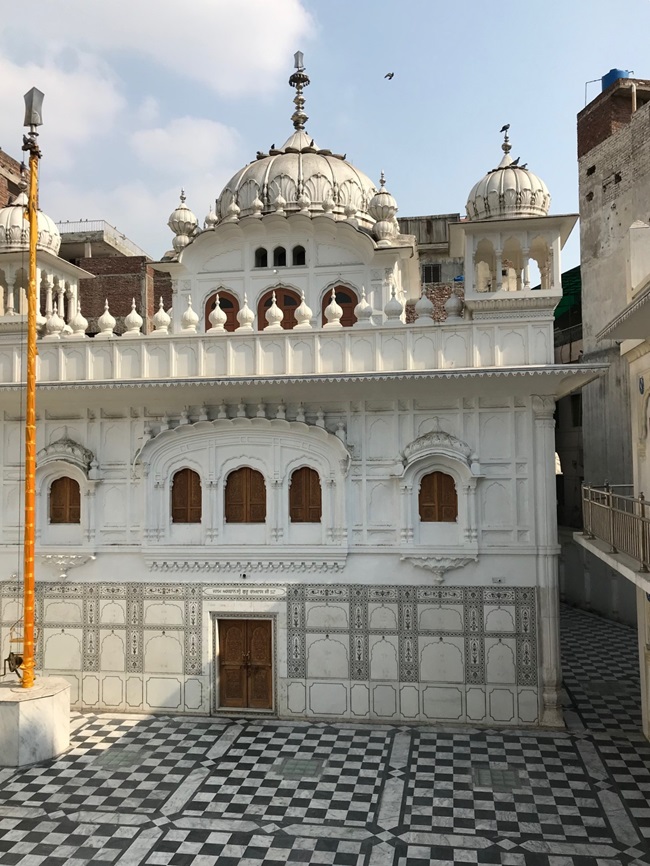
Baba Amar Das (who later became the third Guru in 1552) was from Basarke and had met Bhai Jetha there. Baba Ji asked his grandmother for permission to take him to Goindwal Sahib in 1546, as a new city was being developed there by Baba Amar Das. There he became a dedicated, trusted Sewadar (one who selflessly serves). Over the years, Baba Ram Das Ji grew very close with Guru Amar Das including his family and was married to Bibi Bhani daughter of Guru Ji’s in 1553.
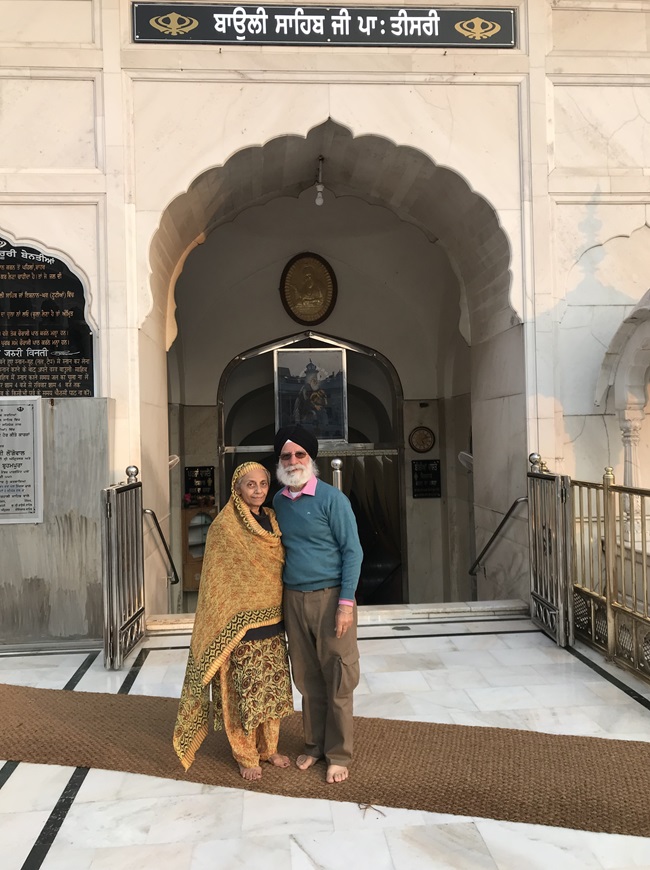
In 1558, Guru Amar Das Ji after returning from the preaching tour of Eastern places of Hindu pilgrimage started the construction of 84 Step Bawli (Step Well), where Baba Ram Das worked with a complete dedication. Some of Baba Ji’s relatives on their way to pilgrimage had stopped there for a night. They spotted Baba Ram Das carrying a basket of dirt on his head and doing other menial work. They were offended and complained to Guru Ji about the shabby treatment of his own son-in-law. But they were not privy to Baba Ji’s thought process, which he later included in his Bani after becoming fourth Guru as:

“Guramukh Saevaa Ghaal Jin Ghaalee.
Tis Gharreeai Sabadh Sachee Ttakasaalee. 2.”
(SGGS, Pg. No. 1134)
Translation: Whoever, as Gurmukh, serves and make efforts to meditate, is molded (as character becomes immaculate) and shaped in the true mint of the Shabad, the Word of God. ||2||
When Emperor Akbar received some complaints against Guru Amar Das Ji in 1566, he was summoned to Lahore by the Emperor. Guru Ji deputed Baba Ram Das to go there in his place, to refute the charges one-by-one. The emperor was so impressed and convinced with the replies that Baba Ji gave, he was honored with a robe of honor and the charges dismissed.
Next in June 1570, Guru Amar Das took Baba Ji on a visit to Sultanwind area. There after some purchasing land, Guru Ji laid the foundation stone of new city called Guru Ka Chakk (now called Amritsar). Guru Ji gave detailed instructions to Baba Ji about the type of township he wanted, along with a pool as the central point. Guru Ji instructed Baba Ji to stay there to oversee the construction of township. One time when Baba Ji returned back to Goindwal for an audience with Guru Ji, he appraised Guru Ji on the progress of development of township. Hearing the details of the progress, Guru Ji was very pleased that he predicted, one day it will become a most significant pilgrimage place.
Guru Amar Das had anointed Baba Ram Das as his successor fourth Guru on September 01, 1574, after putting both of his sons-in-law through a test of constructing a wooden platform for his use. Baba Ram Das Ji built and rebuilt the platform seven times as Guru Ji was not satisfied with them, while the other son-in-law gave up after third try. Guru Amar Das Ji deemed Baba Ram Das as his successor. Guru Ram Das uttered these words after the anointment ceremony:

“Hum rulate firate koiee baat na poochhataa gur satigur sa(n)g keere ham thaape.
Dha(n)n dha(n)n guroo nanak jan keraa jit miliaai chooke sabh sog sa(n)taape. 4.5.11.49.”
(SGGS, Pg. No. 167)
Translation: I was rolling around in the dirt, and no one cared for me at all. In the Company of the Guru, the True Guru, I, the worm, have been raised up and exalted. Blessed, blessed is the Guru of servant Nanak, meeting Him, all my sorrows and troubles have come to an end. ||4||5||11||49||
These words of Guru Ram Das were not mere expressions of humility, but in these words we can feel a genuine appreciation, reverence of his Guru who had exalted a lowly orphan to the highest spiritual pedestal. In the meantime, the work on the excavation of the pool continued in Amritsar. Bhai Gurdas has painted its picture in these words:

“BaiThaa sodhee paatisaahu raamadhaas satiguroo kahaavai.
Pooran taal khaTaiaa a(n)mritasar vich jot jagaavai.”
(Bhai Gurdas, Vaar 1.47)
Translation: Now Guru Ram Das, a Sodhi emperor, seated on the Guru-seat is called the true Guru. He got dug the complete holy tank and here settling down at Amritsar, he spread his light.
In 1581 Guru Ram Das Ji anointed his third son as his successor fifth Guru. Baba Prithi Chand, the eldest son did not accept the decision, he felt by-passed as he considered himself a natural heir being the eldest. Guru Ji tried to explain the rationale of the decision to him, but still he would not relent. When Guru Ji found that it was not convincing to Prithi Chand, he uttered these words and withdrew himself with his family to Goindwal. Guru Ram Das merged in the Eternal Light and returned back on September 1, 1581; he was 47 old at that time.

“Kaahe poot jhagarat hau sa(n)g baap.
Jin ke jane baddeere tum hau tin siau jhagarat paap. 1. Rahaau.”
(SGGS, Pg. No. 1200)
Translation: O son, why do you fight with your father? To fight with those (parents), who gave you birth and raised you, is sin.” ||1||Pause||
Let us get back to construction of township called Guru Ka Chakk (now called Amritsar). After succeeding Guru Ram Das Ji, the fifth Guru continued the efforts to bring the project to completion. Guru Arjan Dev Ji laid the foundation stone of the Sri Harimander (Darbar) Sahib in the midst of the pool in October 1588. This was done after the construction of the pool (sarovar) was completed.
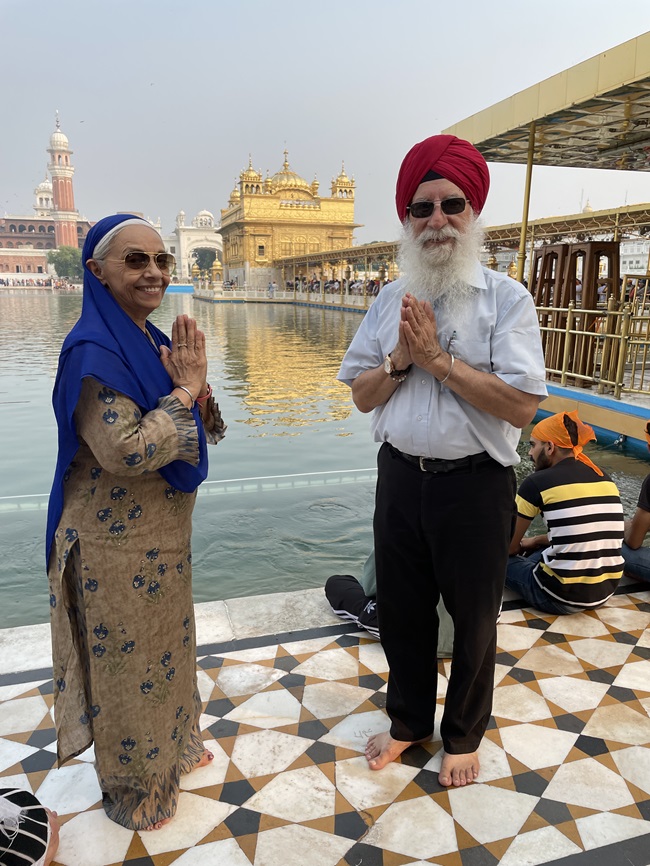
Then Guru Arjan Dev Ji after his return for a long preaching tour initiated the compilation of Sri Guru Granth Sahib in 1603. In September 1604 the completed Granth was formally installed in Sri Harimander Sahib. Guru Ji’s emotions and feelings of awe with the atmosphere around Sri Harimander Sahib is expressed in these words (Note the township was then called Ramdaspur in honor of Guru Ram Das’s legacy, which later was changed to Amritsar after the sarovar there):
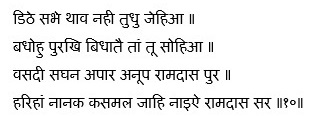
“DdiThe sabhe thaav nahee tudh jehiaa.
Badhoh purakh bidhaatai taa(n) too sohiaa.
Vasadhee saghan apaar anoop raamadhaas pur.
Harihaa(n) naanak kasamal jaeh naiaai raamadhaas sar. 10.”
(SGGS, Pg. No. 1362)
Translation: I have seen all places, but none can compare to You. The Primal Lord, the Architect of Destiny, has established You; thus, you are adorned and embellished. Ramdaspur is prosperous and thickly populated, and incomparably beautiful. O Lord! Bathing in the Sacred Pool of Raam Daas, the sins are washed away, O Nanak. ||10||
What a tumultuous life journey of Bhai Jetha Ji, who rose from a very humble background to become Guru Ram Das Ji, without any formal education or academic credentials under his belt. Yet he composed Bani, a total of 638 hymns and put those to 30 different musical scales called Ragas. His most famous composition is Anand Karaj (meaning blissful ceremony), which is sung as an integral part of the wedding ceremony. Guru Ram Das was noted for his humility, piety, and service to others. We get an authentic portrait from the writings of Bhatts, who had visited Goindwal in search of spiritual bliss. According to Prof. Sahib Singh from the Sawaiya of Bhatt Harbans, it is evident the Bhatts had come just few days after departure of Guru Ram Das from this world in 1581.
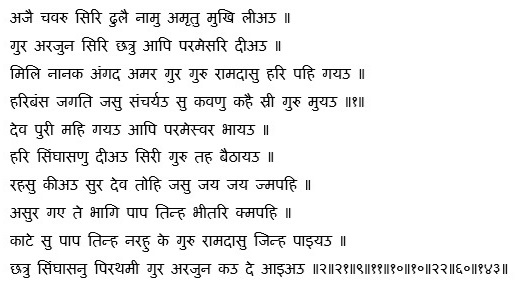
“Ajai chavar sir ddulai naam amrit mukh leeaau.
Gur arjun sir chhatr aap paramesar dheeaau.
Mill nanak angad amar gur gur raamadhaas har peh gayau.
Harbans jagat jas sa(n)charayeau su kavan kahai sree gur muyau. ||1||
Dev puree meh gayau aap paramesavair bhaayau.
Har singhaasan dheeaau siree gur teh baiThaayau.
Rahas keeaau sur dhev toh jas jay jay ja(n)peh.
Asur ge te bhaag paap tin(h) bheetar ka(n)peh.
KaaTe su paap tin(h) narahu ke gur raamadhaas jin(h) paiyau.
Chhatr singhaasan pirathamee gur arajun kau dhe aaiaau. 2.21.9.11.10.10.22.60.143.”
(SGGS, Pg. No. 1409)
Translation: The invincible chaur, the fly-brush, waves over His head; with His mouth, He drinks in the Ambrosial Nectar of the Naam. The Transcendent Lord Himself has placed the royal canopy over the head of Guru Arjun. Guru Nanak, Guru Angad, Guru Amar Das and Guru Raam Das met together before the Lord. So, speaks HARBANS: Their Praises echo and resound all over the world; who can possibly say that the Great Guru (Ram Das) is dead? ||1|| When it was the Will of the Transcendent Lord Himself, Guru Ram Das went to the City of God. The Lord offered Him His Royal Throne and seated the Guru upon it. The angels and gods were delighted; they proclaimed and celebrated Your victory, O Guru. The demons ran away; their sins made them shake and tremble inside. Those people who found Guru Ram Das were rid of their sins. He gave the Royal Canopy and Throne to Guru Arjun and came home. |2||21||9||11||10||10||22||60||143||
When Guru Arjan Dev Ji compiled the Guru Granth Sahib he included the 123 Sawaiyas compositions of these Bhatts, popularly known as Bhatt Bani in Guru Granth Sahib. These were written in praise of the first five Gurus, and out of the total, 60 Sawaiyas (almost 50%) were in praise of Guru Ram Das. In fact, a very interesting aspect of these Bhatt compositions is that every morning at the time of Parkash of Sri Guru Granth Sahib, at Sachkhand Sri Darbar Sahib, Amritsar; at least five Sawaiyas in honor of Guru Ram Das are recited by selected five individuals one at a time. This nostalgic tradition is a carryover from a centuries old tradition of reciting Sawaiyas in honor of the emperor when he first arrived in the court. From one Sawaiya we can get a feeling of how the Bhatts were impressed by Guru Ram Das Ji. In fact, if we watch the daily live telecasts from Sri Darbar Sahib, Amritsar, this Sawaiya is quite frequently sung, more so on the occasions associated with Guru Ram Das.

“Hum avagun bhare ek gunn naahee amrit chhaadd bikhai bikh khaiee.
Maya moh bharam pai bhoole sut dhaaraa siau preet lagaiee.
Eik uttam panth sunio gur sangat teh milant jam traas miTaiee.
Eik aradhaas bhaaT keerat kee gur raamadhaas raakhahu saranaiee. 4.58.”
(SGGS, Pg. No. 1406)
Translation: I am overflowing with sins and demerits; I have no merits or virtues at all. I have abandoned the Ambrosial Nectar (Naam), and I drank poison instead. I am attached to Maya and deluded by doubts; I have fallen in love with my children and spouse. I have heard that the most exalted Path of all is the Sangat, the Guru's Congregation. Joining it, the fear of death is taken away. Keerat the poet offers this one prayer: O Guru Ram Das, save me! Take me into Your Sanctuary! ||4||58||
The words of Bhatt Keerat makes us gauge the desperate situation he finds himself in, along with his spiritual quest. Here he is making a most sincere, humble prayer before Guru Ji to take him in Guru Ji’s sanctuary. These words reflect that these were uttered in the presence of Guru Ram Das himself, and Bhatt had that confidence in where his own redemption lay. Bhatt Mathura claimed (SGGS, Pg. No. 1408) that his speech became sweet gazing upon the blessed vision of Guru Ram Das. Let us also pray that may Guru ram Das Ji bless us with his Grace which may transform our lives as well like it did for the 11 Bhatts.
References:
1. Singh, Prof. Sahib. Sri Guru Granth Sahib Darpan. Volume 10
2. Jagdev, Santokh S. Bed Times Stories – 5.
3. Singh, Bhai Vir. Sri Asht Gur Chamatkar. Part 1 and 2 Combined.
4. thesikhencyclopedia.com/biographical/sikh-gurus/ram-das-guru/
5. discoversikhism.com/sikhs/bhatts_bards.html
6. sikhiwiki.org/index.php/Bhatt_Bani
12-Oct-2024
More by : Bhupinder Singh